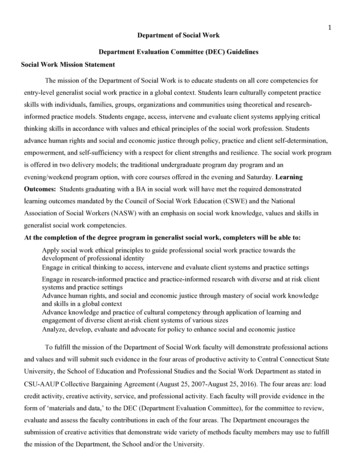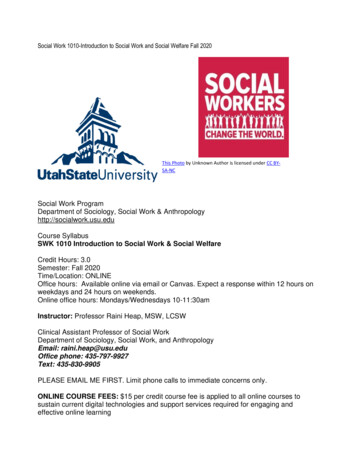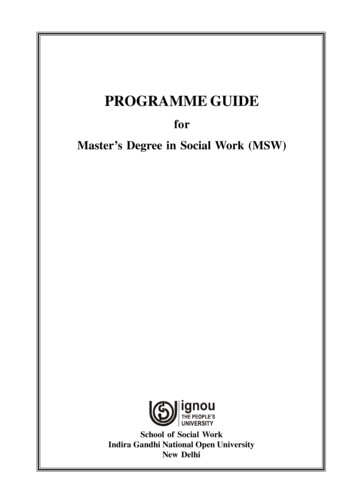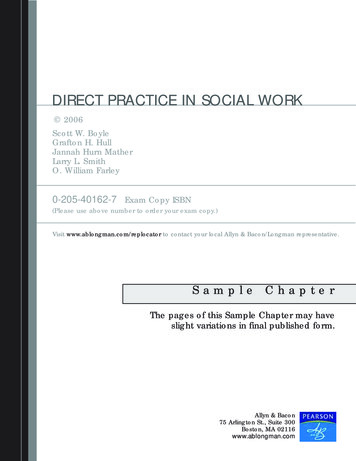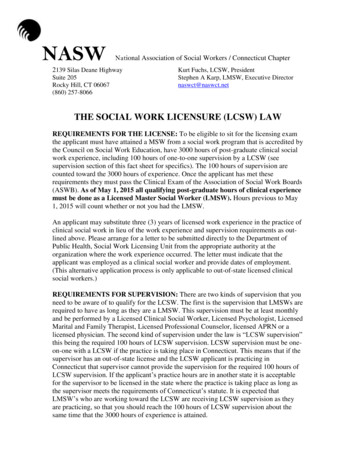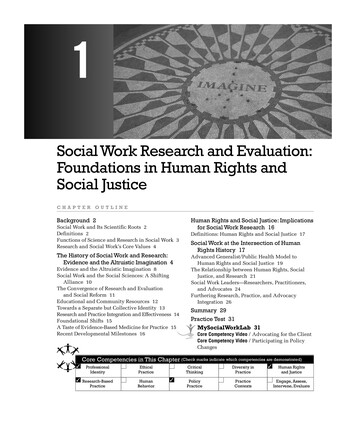
Transcription
M01 MASC4948 01 SE C01.qxd8/25/1111:40 AMPage 11Social Work Research and Evaluation:Foundations in Human Rights andSocial JusticeCHAPTER OUTLINEBackground 2Social Work and Its Scientific Roots 2Definitions 2Functions of Science and Research in Social Work 3Research and Social Work’s Core Values 4The History of Social Work and Research:Evidence and the Altruistic Imagination 4Evidence and the Altruistic Imagination 8Social Work and the Social Sciences: A ShiftingAlliance 10The Convergence of Research and Evaluationand Social Reform 11Educational and Community Resources 12Towards a Separate but Collective Identity 13Research and Practice Integration and Effectiveness 14Foundational Shifts 15A Taste of Evidence-Based Medicine for Practice 15Recent Developmental Milestones 16Human Rights and Social Justice: Implicationsfor Social Work Research 16Definitions: Human Rights and Social Justice 17Social Work at the Intersection of HumanRights History 17Advanced Generalist/Public Health Model toHuman Rights and Social Justice 19The Relationship between Human Rights, SocialJustice, and Research 21Social Work Leaders—Researchers, Practitioners,and Advocates 24Furthering Research, Practice, and AdvocacyIntegration 26Summary 29Practice Test 31MySocialWorkLab 31Core Competency Video / Advocating for the ClientCore Competency Video / Participating in PolicyChangesCore Competencies in This Chapter (Check marks indicate which competencies are demonstrated) ProfessionalIdentity Research-BasedPracticeEthicalPracticeHumanBehavior CriticalThinkingDiversity inPracticePolicyPracticePracticeContexts Human Rightsand JusticeEngage, Assess,Intervene, Evaluate
M01 MASC4948 01 SE C01.qxd8/25/11211:40 AMPage 2Chapter 1BACKGROUNDSocial Work and Its Scientific RootsIn pursuit of new possibilities and a betterworld, research and evaluation strategies forpractice have been acommon thread woventhroughout social workhistory.Social work has reached a significant developmental milestone in its professional identity as it collectively celebrates over a century of professional practice that targets individual and societal transformation (Popple & Leighninger,2007). Historically, social workers have used a combination of research andpractice strategies to advocate for improved social conditions for underservedpopulations, such as the poor, immigrants, political refugees, child abuse victims, and criminal offenders (Day, 2008; Maschi, Bradley, & Ward, 2009). Infact, social workers’ striving for “new possibilities” for humankind parallelsthe global social movement for human rights (United Nations [UN], 1994),particularly with the emphasis on the “intrinsic” value of every person, andthe use of individual and group action to promote social justice as a form of“equitable social structures that provide people security and developmentwhile upholding their dignity” (International Federation of Social Work[IFSW], 1988, p. 1).In pursuit of new possibilities and a better world, research and evaluationstrategies for practice have been a common thread woven throughout socialwork history. Social work research and evaluation continue to evolve as a mechanism that gathers data that can be used toward enhancing well-being and socially just outcomes (Wronka, 2008). Since the beginning of the profession,research in the form of the scientific method has been used to understand individual and social problems and to guide, assess, and intervene with underservedpopulations, especially the poor (Zimbalist, 1977). In fact, the United Nations(1994) has made a distinct reference to social work as a human rights professionbecause of its long-standing commitment to well-being and justice. Research andevaluation are important aspects for helping the profession achieve its mission.According to the Council on Social Work Education (CSWE, 2008):The purpose of the social work profession is to promote human andcommunity well-being. Guided by a person and environment construct,a global perspective, respect for human diversity, and knowledge basedon scientific inquiry, social work’s purpose is actualized through thequest for social and economic justice, the prevention of conditions thatlimit human rights, the elimination of poverty, and the enhancement ofthe quality of life for all persons. (p. 1)DefinitionsSocial workers need to be clear about the meaning of common terms. As notedearlier, scientific inquiry informs the profession’s purposes. Scientific inquirycommonly refers to the process of gathering fact-based information in a systematic way. In social work, it refers to the process by which social workers askquestions, develop and carry out investigations, make hypotheses or predictions, gather evidence, and propose explanations or corroborate evidence(Gibbs & Gambrill, 1998). An essential component of scientific inquiry is critical thinking, which is the intellectually disciplined process of “actively andskillfully conceptualizing, applying, analyzing, synthesizing, and/or evaluatinginformation gathered from, or generated by, observation, experience, reflection,
M01 MASC4948 01 SE C01.qxd8/25/1111:40 AMPage 3Social Work Research and Evaluationreasoning, or communication, as a guide to belief and action” (Fisher & Scriven,1997, p. 1).Research and evaluation comprise a central feature of social work practicethat can foster and appraise the profession’s progress toward its mission(Wronka, 2008). Research and evaluation are important because they give social workers permission to be curious and creative, as well as systematic andthorough in their activities that involve assessment, prevention, and intervention efforts with individuals, families, and communities.The term research generally refers to a systemic and thorough search orexamination that involves the collection of data (Engel & Schutt, 2010). As averb, research often refers to conducting an exhaustive investigation. The termevaluation often refers to the careful appraisal and study about the effectiveness of an intervention (Barker, 2003). The use of the scientific methods withthe distinct purpose of generating information to apply to practice has historically made social work research and evaluation unique.Functions of Science and Research in Social WorkAlthough some aspects of social work practice are an art, science and researchcomprise an essential component of social work practice activities (Kirk &Reid, 2002). Reid (1997) articulated three major functions for social work practice. First, scientific perspectives and methods can provide a framework forpractice activities and help obtain the best results possible. It is a way of thinking that offers strategies for action. According to Reid (1997):Such an orientation calls for the use of concepts that are clearly tied toempirical events; the systematic collection of data; the cautious use ofinference and the consideration of alternative explanations; the application when possible, of research-based knowledge, and the discriminating evaluation of the outcomes of one’s efforts. (p. 2040)Second, research is an essential tool toward building knowledge that canbe used for practice. Research can serve as a generative tool to develop and refine theories for practice and can be used to evaluate practice effectiveness.When knowledge is empirically grounded, it strengthens practice decisions.Third, research serves a practical function for social workers in the field,to evaluate their own practice with individuals, agencies, or communities. It iscommon for social workers to conduct needs assessment, quality assurance,program and practice evaluation, productivity studies, and program evaluation. Data gathered for specific practice situations can be used to make practice decisions and actions.The professional social work organization, the National Association of Social Workers (NASW, 2010), underscores the diversity of social issues addressed in social work research and its benefits. Social work research targetsan array of psychosocial problems; prevention and intervention efforts; andcommunity, organizational, policy, and administrative concerns. Some areasof research for practice include research on mental health, child maltreatment,community violence, HIV/AIDS, juvenile delinquency, productive aging, substance abuse, and international community development. Other areas of research address risk and resilience, such as community violence, amongindividuals, families, groups, neighborhoods, and society to generate information that can be used to develop or refine practice. Other areas of research examine the effectiveness of service delivery and public policies, achieving3
M01 MASC4948 01 SE C01.qxd8/25/11411:40 AMPage 4Chapter 1human and community well-being and social and economic justice. Moreover,these areas of research can be used to benefit stakeholders that includeconsumers, practitioners, policy makers, educators, and society.Research and Social Work’s Core ValuesCore professional values emphasized in contemporary practice, such as scientific inquiry, also can be traced throughout the profession’s history. In fact, theCSWE emphasizes these core values in its Educational Policy and Accreditation Standards (EPAs) in which Policy 1.1 refers to values. The policy statesthat “service, social justice, dignity and worth of the person, the importance ofhuman relationships, integrity, competence, human rights, and scientific inquiry are among the core values of social work. These values frame the profession’s commitment to respect for all people and the quest for economic andsocial justice” (CSWE, 2008, p. 2).An important component of social work practice has been its efforts in integrating scientific methods with the art of practice, particularly to understandthe causes of poverty and give relief to the poor (Zimbalist, 1977). The integration of science with social work practice was first advanced in the late 1800sas part of the scientific philanthropy movement to address poverty (Orcutt,1990), which was scientific research used as a mechanism to uncover thecauses of poverty, to assess individual families, and to evaluate the effectiveness of social work efforts to assist the poor (Kirk & Reid, 2002).Professional IdentityCritical Thinking Question:How do the core valuesof scientific inquiry andhuman rights and socialjustice help shape yourpersonal professionalidentity and the professionas a collective?Perhaps the profession’sbiggest developmentalchallenge has been integrating the passionate,action-oriented reformerwith the compassionatecounselor/helper, andthe objective scientificobserver.THE HISTORY OF SOCIAL WORKAND RESEARCH: EVIDENCE ANDTHE ALTRUISTIC IMAGINATIONAs the social work profession moves forward into 21st-century practice, a clearunderstanding of its historical roots can be used to inform current practices,especially those related to the roles and functions of social work research andevaluation. A review of history reveals the birth of the profession based on humanitarianism during turbulent times in which poverty, discrimination, andpolitical corruption were rampant, and two world wars were waged killingmillions of world citizens.In the late 19th century, a group of like-minded citizens banded togetherin the pursuit of humanistic ideals to help reinvent a better and more justworld. Social workers actively used scientific methods, such as descriptivesurveys and outcome studies, to achieve their aims of identifying adverse societal conditions or evaluating their practice. Significant progress in educational, practice, and policy reform was made using evidence that it wasresearch that guided practice and practice that guided research. Table 1.1 provides a significant timeline of life events for social work, with an emphasis onresearch and evaluation milestones.Perhaps the profession’s biggest developmental challenge has been integrating the passionate, action-oriented reformer with the compassionatecounselor/helper, the objective scientific observer within each individualsocial worker, and the collective profession. In the following review, socialwork history suggests that some of the most advanced achievements occurred
M01 MASC4948 01 SE C01.qxd8/25/1111:40 AMPage 55Social Work Research and EvaluationTable 1.1Social Work Research History: Developmental MilestonesDatesSocial work research history1800sRise of the Scientific Philanthropy Movement1841Dorothea Dix first advocates for conditions of mentally ill in prison1884National Conference on Charities and Corrections (NCCC)1860sBoard of Charities and Corrections formed; Rise of Charity movement and friendly visitors andthe settlement house movement (research, reform, and residence); Dorothea Dix continues toadvocate mentally ill in prisons; creation of state hospitals1865American Social Science Association established; Organized by Franklin Sanborn, gen secof MA Board of Charities1878National Conference of Charities and Corrections formed1884The settlement house, Toynbee Hall, in England established1889Jane Addams and Ellen Starr establish Hull House, the first settlement house in the UnitedStates1890U.S. Jacob Riis publishes How the Other Half Lives, photographic survey of how NY poor lived1894American Charities: A Study of Philanthropy and Economics A.G. Warner published—on mixedmethods study on poverty1895“U.S. Hull House Maps and Papers” published, documenting problem of Chicago’s new immigrants1897“1897—The Influential Pittsburgh Survey Study” conducted by Charity workers. The PhiladelphiaNegro: A Social Study—documented the trials of urban AA1898The City Wilderness Robert Wood’s-Boston-New Immigrants and Poverty1899Juvenile court is established in Chicago1900–1920Separation takes place between professional SW education and academic social sciences1900Educator Simon Patten coins the term social worker to describe friendly visitors and settlementhouse workers; Staggering youth statistics spur growth of child-saving movement; journalsCharities and Commons published1902London—Charles Booth’s The Life and Labour of the People of England published1906School social work programs are established in New York and other U.S. cities, journals Charitiesand Commons are combined to become the journal Charities and Commons1907–1916Jane Addams publishes six books and numerous essays1907Russell Sage Foundation formed; Pittsburgh Study begins, establishes a department of surveysand exhibits, provides grants to establish social research in schools of social work1909Jane Addams—First woman to be elected president of the NCCC; Last American Social ScienceAssociation held1912U.S. Children’s Bureau established—Julia Lathrop of Hull House instrumental in data gathering,local and national; Robert Chapin’s report is published “The Standard of Living among Workingmen’s Families in NYC”(continued)
M01 MASC4948 01 SE C01.qxd68/25/1111:40 AMPage 6Chapter 1Table 1.1Social Work Research History: Developmental Milestones (Continued)DatesSocial work research history1915Abraham Flexner’s famous address “Is Social Work a Profession” at the 42nd annual session ofthe National Conference of Charities and Corrections1917NCCC now National Conference of Social Workers; Mary Richmond publishes social diagnosis1919School of Social work forms an association that later becomes CSWE1920sSigmund Freud’s theories gain prominence in social work; Sophie van Senden conducts researchon youth in foster care through charity organization1920U.S.—Mary Richmond came up with first experimental code of ethics1921Tuft report on SW education; Mary Richmond receives honorary degree from Smith College forestablishing the scientific base of SW1922Mary Richmond’s What Is Social Casework? published1923Tufts (1923) published education and social work1927Social Service Review Journal is started by Abbott and Breckinbridge of Hull House1928The Milford Conference reports distinguished general and specific components of social work practice1929Growth of Freudian thought in social work casework to examine individual problems; Rise ofdiagnostic and functional schools of thought1930Functional school of social casework develops psychosocial approach; 1931 Conference ofSocial Work, Cabot’s speech urges social workers to evaluate their practice1931Jane Addams receives the Nobel Peace Prize; Edith Abbott advocates for the use of scientificmethod in SW19371937 SW Yearbook—distinction is made between social research and social work research1938Conference of Evian is held in response to Third Reich1939“The Lane Report”—text on community organizing builds on Lindeman’s 1921 text; Cabot startsCambridge-Somerville Youth Study focused on juvenile delinquency1945Emily Green Balch, SW reformer and SW educator, receives Nobel Peace Prize1947Landmark conference that distinguishes between social research and social work research;Social Work Research Group is established1948Universal Declaration of Human Rights is adopted, National Conference of Social Workers 19481949Establishment of the Institute of Mental Health1950sCommunity Planning for Human Services-Community Level Research Project; research becomescentered in schools of social work; SW doctoral education programs grow1951SWRG begins to index social work research abstracts1952Council on Social Work Education forms after merging of educational organizations; Frenchprepare an Approach to Measuring Results in Social Work, published to examine serviceeffectiveness; SW schools include a research thesis in MSW programs
M01 MASC4948 01 SE C01.qxd8/25/1111:40 AMPage 7Social Work Research and EvaluationTable 1.1Social Work Research History: Developmental Milestones (Continued)DatesSocial work research history1955Specialty section in NASW—Council on SW Research; National Association of Social Workersis formed when SW groups merged, including SWRG1959Boehm’s (1959) Social Work Curriculum Study Project1960s–1970sShift from social work research conducted in agencies to universities, expansion of SW doctoraleducation; Russell Sage is no longer a major funder of SW research1960NASW first Code of Ethics is established (one page); First SW Research text published, editedby Norman Polansky under auspices of NASW71961 legislation establishing the President’s Committee on Juvenile Delinquency and Youth;Crime-funded community demonstration projects1964War on Poverty is launched and beginning of community action projects1965NASW publishes Research and Abstracts1970sConcerns about the bridge between research and practice grow in SW profession1972Fordham University Symposium reviews 13 direct service research projects from 1960s1973Fischer—Is Social Case Work Effective?: A review is published; caused an ongoing debateabout practice effectiveness19741974 reorganization of NASW; subsumes disparate SW organizations under one umbrella;NASW abolished special interest groups for one unified definition1975Group for the Advancement of Doctoral Education-Social Work (GADE) is formed1976IFSW—adopts first international code of ethics1977Zimbalist publishes Historic Themes and Landmarks in Social Welfare Research; NIMH fundsresearch conference for CSWE to document gap between research and practice in MH1978NIMH funds research conference for NASW to document gap between research and practicein MH1979NASW Code of Ethics expand to 10-page document conduct provisions (1990 and 1993)Jayartne & Levy (1979) Empirical Clinical Practice Model published1980s–NIMH funding shifts from funding clinical practitioners to research on treatment1981Dinerman (1981) report—documents the disconnect between research and practice1982“1982 CSWE Curriculum Policy Statement”—integration of research in practice1981Heineman’s The Obsolete Scientific Imperative in SW Research—ignites ongoing debate aboutresearch for practice1984CSWE accreditation requirement for practice-based research1986IFSW Code of Ethics is supplemented by a declaration of ethical principles; NIMH directorauthorizes the creation of task force on SW Research(continued)
M01 MASC4948 01 SE C01.qxd88/25/1111:40 AMPage 8Chapter 1Table 1.1Social Work Research History: Developmental Milestones (Continued)DatesSocial work research history1988“1988 CSWE Curriculum Policy Statement”—curriculum should impart knowledge for practiceand evaluate services1990sNIMH funds eight developing research centers; Rise of evidence-based practice in medicinefollowed by social work19911991 report—“Task Force on SW Research,” supported by NIMH, published report, “BuildingSW Knowledge”1993Establishment of Institute for the Advancement of Social Work Research (IASWR)1994Society for Social Work Research is formed1994NASW establishes SW Research journal, founding of the Society for Social Work Research1994United Nations (1994) publishes “Human Rights and Social Work” manual19961996 Code of Ethics by NASW; ANSWER is established—advocacy network for increasedsupport for SW research1998A Report on Progress in the Development of Research Resources in Social Work (IASWR, 1998)1999Legislation is filed to establish a National Center for SW Research2000National Institute on Drug Abuse creates the SW Research Development Program and providesgrants2001Ife (2001) publishes Human Rights and Social Work2002Kirk and Reid (2002) publish Science and Social Work, which critically appraises past effortsto make SW more scientific2003Reichert (2003) publishes Social Work and Human Rights2004IFSW and IASSW adopt new ethical document—Ethics in SW: Statement of Principles2008Wronka (2008) publishes Social Justice and Human Rights2009SWRnet is established; IASWR is disbanded2010Journal of Society for Social Work Research is establishedwhen these three aspects of passion, compassion, and rationality were respected. Also, passionate debates among social workers resulted in new understanding of the roles and functions of research in social work.Evidence and the Altruistic ImaginationIn the mid-19th century, many concerned citizens and volunteers began their humanitarian efforts to address growing social problems, particularly in urbanAmerica where poverty and substandard living and working conditions wererampant. They began to use a variety of research methods to understand and assist
M01 MASC4948 01 SE C01.qxd8/25/1111:40 AMPage 9Social Work Research and Evaluationdisenfranchised populations, which included people with mental illness, thepoor, racial and ethnic minorities, at-risk youth, and prisoners.Perhaps one of the most notable 19th-century humanitarians who used research strategies for advocacy purposes was Dorothea Dix (Viney & Zorich,1982). In the early 1840s, Dorothea Dix began her in-depth observation of thetreatment of people with mental illness in jails and prisons. She used the findings of her observational notes to increase awareness of the inhumane treatment meted out behind closed correctional doors. She also used her findingsto advocate for improved conditions for this population. The following excerptis an appeal she made to the Massachusetts Legislature in 1845:In illustration of my subject, I offer the following extracts from my NoteBook and Journal. I found, near Boston, in the Jails and Asylums for thepoor, a numerous class brought into unsuitable connection with criminals and the general mass of Paupers. I refer to Idiots and Insane persons, dwelling in circumstances not only adverse to their own physicaland moral improvement, but productive of extreme disadvantages to allother persons brought into association with them.As Dix has stated, her observational notes were a source of documentedevidence of the mistreatment of the mentally ill. Her use of this data to persuade state legislatures and the media was quite fruitful. Dix is attributed withalmost single handedly leading social reform efforts for the treatment of thementally ill and the establishment of state hospitals for their institutional care,both nationally and abroad (Dix, 1975).In the late 19th century, a growing number of concerned citizens joined theranks of the charity and settlement house movements, volunteers (Day, 2008).In 1884, Toynbee Hall in England was established to address community problems including poverty and overcrowding. Inspired by this work, five yearslater in 1889, Jane Addams and Ellen Starr established Hull House in Chicago,Illinois. The success of their efforts has been attributed to three words that begin with r: residence, research, and reform. Residence was in the form of living in the midst of the community. Research involved quantitative andqualitative approaches that included community mapping and observationaland interview data. Reform efforts included legislative advocacy at the local,state, federal, and international levels.Other related but notable social reform efforts included public awarenessefforts by the media. Jacob Riis (1890) was an innovative photojournalist of theNew York City slums. In 1890, in his book How the Other Half Lives, Riiswrote about children in slums:I counted the other day the little ones, up to ten years or so, in a BayardStreet tenement that for a yard has a triangular space in the centre withsides fourteen or fifteen feet long, just room enough for a row of ill-smellingclosets at the base of the triangle and a hydrant at the apex. There wasabout as much light in this “yard” as in the average cellar. I gave up my selfimposed task in despair when I had counted one hundred and twenty-eightin forty families. (p. 58)This photographic survey of how the New York poor lived was an eyeopener to many American citizens who were unaware of the substandard living conditions of the urban poor.9
M01 MASC4948 01 SE C01.qxd108/25/1111:40 AMPage 10Chapter 1Social Work and the Social Sciences: A Shifting AllianceIn the late 1800s, the rise of the scientific philanthropy movement and the useof the scientific method helped social scientists to understand and intervenewith pressing social problems. These problems included mental health, politicalcorruption, crime-ridden streets, juvenile delinquency, exploitative workconditions, and immigrants living in urban slums. Social scientists, fromdisciplines such as history, anthropology, political science, and psychology,banded together to help understand the nature of these pressing social problems. In 1865, an interdisciplinary collaboration of social scientists formed theAmerican Social Science Association (ASSA) (forerunner of the American Sociological Association) (Broadhurst, 1971; Kirk & Reid, 2002).The social problem-solving aims of the social scientists were consistentwith members of state boards of charity organizations engaged in the field.Both parties also were eager to break away from the prevailing religious prescriptions for society’s ills and instead adopt a rational-minded scientificmethod to understand and combat societal ills. A common ground between thecharity organization members and social scientists was their shared concernover the wide-scale social problems and the need for social and legislative reforms. In 1874, Franklin Sanborn, who was the general of the MassachusettsBoard of Charities, organized a historic meeting between state boards of charities members and the ASSA social scientists at their annual ASSA meeting(Austin, 2003; Zimbalist, 1977).With these similar agendas, an organizational alliance was formed, and thesocial welfare group met under an ASSA special section, titled Social Economy.However, this union was short-lived (1874 to 1879). Although they sharedcommon concerns over social problems, the charity board members and socialscientists differed on the purpose and especially on the importance of theapplication of their research and evaluation findings.Eventually, the charity board members found the social scientists’ fixationwith abstract social theory development limiting, especially when they werefaced with practical management issues facing frontline practitioners (Broadhurst, 1971). A philosophical split seems to have occurred between scientificdetachment and the pursuit of humanitarian ideals and passionate socialchange efforts. To address their specific aims, the state boards of charitiesstarted their own organization, the National Conference of Charities and Correction, in 1878. It included Charity Organization Societies (COS) and emphasized their agenda, which was the use of the scientific methods for practicalapplications. This system included philanthropic, nongovernmental socialwelfare organizations that focused on the problems of urban poverty and othersocial problems, such as orphaned and abandoned children, as well as a network of state-administered institutions, such as orphanages, mental institutions, and correctional institutions (Austin, 2003; Zimbalist, 1977).The ASSA social scientists disbanded in 1909. Social scientists from theirrespective disciplines developed associations for their own specializations.The debate about the purpose of research eventually had a winner. As historyhas shown, the emphasis on objective theory building and knowledge building, often referred to as social research, and not its practical applications to address social problems, became the major focus of academic social sciencedepartments during the first half of the 20th century.The gap in the field for more directly applied research and evaluation efforts was largely filled by members of the emerging social work profession.
M01 MASC4948 01 SE C01.qxd8/25/1111:40 AMPage 11Social Work Research and EvaluationThe loosely knit group of charity workers and community volunteers becameknown as social workers when Simon Patten, a social work educator, coinedthe term in 1900. The profession wanted to move beyond pure armchair theorizing to compassion in action. However, it would be another 33 years beforethe profession’s developmental milestones in which ownership of the uniquefeatures of research in social work took root. In 1933, the publication SocialWork Yearbook in
the distinct purpose of generating information to apply to practice has histori-cally made social work research and evaluation unique. Functions of Science and Research in Social Work Although some aspects of social work practice are an art, science and research comprise an essential component of social w
